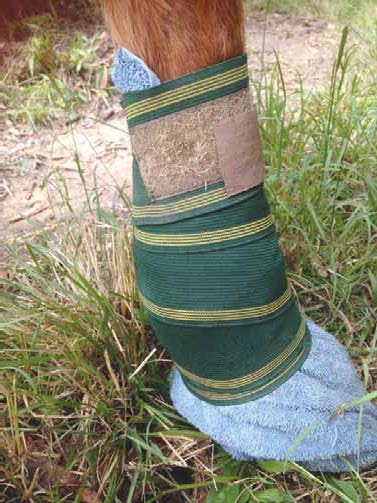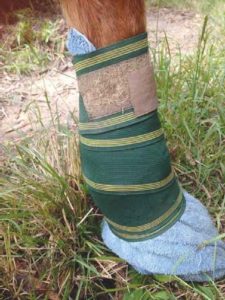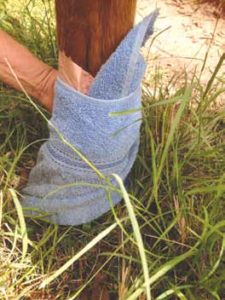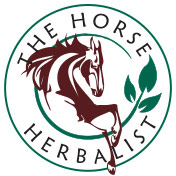
Blog
For centuries, poultices have been used on horses to relieve soreness and inflammation. Generally consisting of clays that help reduce swelling or draw out infections, they often contain medication or herbs to improve effectiveness. Basically, a poultice consists of a soft, moist material that is applied to the affected area, and can have a cooling or warming effect depending on the ingredients and how they are applied.
 Warm poultices are generally used to draw out ‘pus’ or inflammation and are often used for hoof abscesses and sole injuries. A poultice should always be tested against your skin to ensure it isn’t too hot for the horse.
Warm poultices are generally used to draw out ‘pus’ or inflammation and are often used for hoof abscesses and sole injuries. A poultice should always be tested against your skin to ensure it isn’t too hot for the horse.
Cold therapy poultices helps to reduce pain and minimise swelling and the trend is to use this as a preventative treatment after exercise. These can be cooled in the fridge before applying. The poultice is then covered with a damp cloth or damp brown paper, to retain the cooling effect, before bandaging. The heat from the horse’s leg will gradually warm the poultice, which can then be replaced.
While there are many commercially produced poultices and clays, that are great for the time-poor horse owner, the tried-and-true methods of using herbs and other readily available produce are still well recognised and used today.
The word Poultice comes from the latin ‘puls’ – a thick porridge. A poultice is therefore a moist, often heated application for the skin to treat inflamed areas, improve circulation and draw pus or invasive matter.
MAKING A POULTICE
Using Epsom salts and bran as an example of a hot poultice. You will need
A bucket, Epsom salts, bran, hot (not boiling) water, the corners of hessian bags are ideal to make a hoof poultice, but are difficult to find these days so substitute hessian with an old tee shirt, tea towel or similar material, and a bandage.
Method
Add approximately 2 heaped tablespoons of Epsom Salts to 1-2 litres of hot water and dissolve, then add bran until you have a moist firm consistency like thick porridge.
Application:
Apply as a hot poultice straight on skin/sole then wrap. For a suspected abscess or inflammation apply the poultice to the sole of the affected hoof, including up over the coronet if needs be. Pack well, then place the hoof into the hessian corner or similar, apply the bandage around the lower cannon bone, then down over the fetlock, securing the hessian in place.
The horse should be kept in a yard or a stable, poulticed overnight, removed in the morning. It may need to be re-applied over 7-10 nights until all the necrotic or infected material is drawn out.
Variations:
Cabbage: Drawing and soothing, anti inflammatory. Chop or grate, boil lightly in a little water, add bran or similar to bind then apply. For painful breast feeding in humans a whole cabbage leaf over the breast gives rapid relief. This would apply to mares when foals are weaned as well and you can give them sage tea orally, 1-2 cups a day, to dry their milk up more quickly. Poultice can be applied warm or cold.
Carrot: Drawing and soothing. Grate carrot, do not discard any of the juice. Some endurance riders use carrot or cabbage poultices immediately after an endurance race to bring rapid relief and a faster recovery to the horse. Apply warm or cold.
Castor oil: A powerful drawing poultice. Bruise the leaves of Castor Oil plant (widespread weed, common in wasteland) and apply. A rub can be made from 2 parts castor oil and 1 part apple cider or wine vinegar – massage twice daily to aid in the reduction of topical tumours, some skin conditions like ringworm and mange. Apply as a warm poultice.
 Comfrey: To assist in rapid healing. If the horse is throwing a splint, ice it first then apply a cold comfrey leaf and/or root poultice.
Comfrey: To assist in rapid healing. If the horse is throwing a splint, ice it first then apply a cold comfrey leaf and/or root poultice.
A poultice made from chopped, lightly boiled leaves and/or root will aid any strains or sprained ligaments. Comfrey will reduce splints (inflammation of the interosseous ligament and the splint bone) if applied whilst the splint is still active. (First ask your vet to make sure you have no breaks or fractures).
Garlic and/or Onion: Both cleansing, antiseptic. Grate or boil, retaining all fluid for use in poultice. Use as a warm or cold poultice.
A cold Aloe bandage is the no.1 treatment as a preventative against swelling after exertion. See the article on Aloe Vera.
Linseed/Flaxseed: Sprains or strained ligaments, abscesses, swellings. Make a mucilaginous (gooey) mash by adding boiling water and simmering for 15 minutes. Can add any of the other healing herbs or vegetables to linseed to make an excellent warm poultice.
Potato: Anti–inflammatory, healing, cooling. Grate potato, retaining all the juice.
The potato is a useful vegetable that is almost always on hand in any household. I have used it extensively as a last ditch effort to heal a number of stubborn skin conditions in horses, humans and dogs alike. It also takes the heat out of burns if applied asap if you don’t have an aloe plant (aloe is my first preference for burns). Potato and aloe combine well also for this cold poultice.
If the area to be treated is too difficult to bandage or poultice then hold a handful of mixture over the area until the potato becomes hot, discard that and repeat for a minimum of 15 minutes 2-3 times daily. Be aware it’s a wet and messy process but you’ll see positive changes to the area within a day or two.
Pumpkin: A good drawing poultice, especially for abscesses and boils. Lightly roast or boil and mash. Apply warm.
Turnip: This is an old remedy used by Dutch farriers for founder/ laminitis. It is a pain inhibitor; giving rapid relief, this cold poultice has a cooling effect.
A number of clients have run into trouble with their pregnant mares foundering and being unable to give veterinary drugs to relieve their pain. Grated or lightly boiled turnip made into a mash and applied as a poultice, has given good results.
This article appears courtesy of Hoofbeats Magazine from the August/September 2016 edition. Angela Davison contributes as part of the Green Horse Team, and delivers hands-on herbal advice to readers. Visit http://www.hoofbeats.com.au/ for subscription details.
